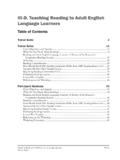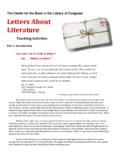Transcription of Lane's English - ESL-Online
1 Lane's English as a Second language by Richard R. Lane, Illustrations by Stefan Munteanu and Leon Samoilovich Book 1. i Copyright 1977; revised 1988, 2000, 2009 by Richard R. Lane All rights reserved. No part of this book may be changed without written permission from the publisher. The world's most efficacious ESL series is given freely to all students and teachers of English by- Lane Press Box 17822. Stanford, CA 94305. USA. ii TABLE OF CONTENTS. PAGE. Foreword Lesson 1 - Body .. 1. a/an, plurals, this/these, What? Lesson 2 - Clothes.. 9. this/these, that/those, or, very, and, "to be" questions, yes/no questions, not, possessive adjectives, colors, Whose? Lesson 3 - Food .. 19. too , some, on/off, nouns used as adjectives, "to be" present tense, numbers, money, How much ? Lesson 4 - World.. 29. the, but, of, in/out of, between, to/from, only, "to be" past tense, much, many, where?, continents and nations, months, What time is it?
2 Lesson 5 - School.. 39. at, with/without, about, for, prepositions and pronouns, "to be" future tense, there is/are, it, some, any, who?, when?, how?, why?, because, how much?, how many?, days, ordinal numbers. Review of Lessons Social Expressions ..58. APPENDIX. Days ..61. Months ..61. Time ..65. Money ..65. iii Intentionally left blank iv FOREWORD. The English language is now closer to being the world's second language than any other since the dominance of Latin in Western civilization. Today, English is the official or first language of 23 nations with a combined population of about 500,000,000. In addition, it is a co-official or widely used second language in another 25 nations with more than 900,000,000. The best estimates are that 50,000,000 primary school students and 75,000,000 secondary school students are currently studying English as a second language . To this can be added millions more who are studying English at the adult and college/university levels.
3 China alone is said to have more people (500,000,000) studying English than the combined populations of the UK (61,000,000). the USA (305,000,000), and Canada (33,000,000) among whom 75%- 80% claim English as their mother tongue. As a student of English , you have a lot of company. You are part of a truly global enterprise. The fact that English is a key to many doors technology, science, business, politics, culture accounts in large measure for its present attractiveness. To any list of causes that might be offered for this widespread use, we should keep in mind that in sharp contrast to those who have made a near fetish out of their languages, native speakers of English have not fixed it within any standard, except intelligibility. The absence of any high authority to decide what is and what is not " English " has given the language a relatively unfettered line of development which is probably more dynamic today than ever before.
4 English has never echoed to any call for "purity." Because it is not afraid of being corrupted and has such a high tolerance for new words and expressions, regardless of their origins, English is able to adapt to local conditions with ease. There have been many well-intentioned efforts directed at the needs of English learners. The traditional approaches were entirely grammar based. These were later supplemented by frequency word counts. Then came the communicative approach, which spawned audio-lingual methods seeking to teach the living language . A more recent development along this line has been Survival English . Looking at these approaches in terms of progress in the language against time and effort expended, the criteria of efficacy, we see that each is found seriously wanting. The grammatical approach to English was nothing more than an extension of the traditional teaching of Greek and Latin.
5 Students had a very difficult time going from their passive knowledge to an active use of the language . Desiring to eliminate such useless sentences as "Lightning has struck my carriage," textbook writers turned to word counts only to discover that students needed a relatively large vocabulary before much of consequence could be said. Though the word count approach strengthened reading and writing abilities, it did little to get students to speak. Thus the door was opened for the communicative approach which demanded students be taught the spoken language in daily situations. But, if we were to teach what students are likely to hear, we would begin with a number of "four-letter" words and then graduate to "I ain't gonna" and "He done it." Since this is unacceptable to most people, teachers and material developers have concentrated on getting and giving information in a number of different situations: the post office, the bus stop, the doctor's office, job interview, etc.
6 Unfortunately, natural conversations in these various situations require a rather extensive vocabulary and command of sophisticated grammatical structures as well as a plethora of idioms. Much of this material seems designed to keep the teacher's interest, rather than approach the problem of language acquisition from the student's perspective. The communicative approach can not be faulted for its goal. The problem lies rather with its lack of any apparent criteria for introducing vocabulary and structures. Beginning students do not need ten ways to say "Hello.". In my own search for an alternative to these approaches to English , I have been attracted by various ideas of simplification, particularly those of C. K. Ogden, the developer of BASIC English . I see simplification as principally a controlled and ordered approach to the language . There is no doubt in my mind that more than 80% of the English language conforms to certain rules and patterns and if students can begin to see this underlying structure or logic, they can experience the joy of communication and gather the momentum to carry them through the rough, illogical parts.
7 Lane's English as a Second language is different because it offers the learner a step-by-step, cumulative approach that unlocks the logic of English . It consciously excludes idiomatic word usage until the learner is prepared to deal with it. By eliminating the capricious and/or arbitrary elements of English , the Lane approach presents the learner with a system, a reasonable, logical linguistic system that can be explained, and therefore understood and mastered. This approach is specifically designed for the learner who wants to know why and the teacher who sees English as more than an inexhaustible jumble of words and expressions best acquired with mother's milk. v The total vocabulary of Lane's English as a Second language is about 1200 words. By limiting the vocabulary, one of the major obstacles to learning English its non-phonetic spelling is skirted. With approximately 200 words to be learned in each book, students need not be burdened with spelling rules and their numerous exceptions.
8 More than half of the words are only one syllable long, so they are easily mastered by speakers of languages that are not cognate to English . The 1200 words were selected on the basis of usefulness, not frequency. The choice was made in accordance with the linguistic tendency toward general and away from specific uses. This allows the vocabulary to be manipulated at various levels of sophistication. In the presentation of this vocabulary, the approach is first to establish the primary meaning of each word and then to expand its usage in a systematic manner. With this expanded usage the 1200 words actually give a learner a level of expressability many times greater. This may be seen graphically as follows (in regard to body parts): 1. BASIC MEANING: This is a hand. 2. Compound words: This is a shoulder bone. 3. Expanded usage: I am the head of my family. 4. Metaphoric: She has a big heart. 5.
9 Set phrases. We came face-to-face with a problem. 6. Idioms (a): The walls have ears. 7. Idioms (b): He put his foot in his mouth. 8. Sayings: His eyes were bigger than his stomach. One of the primary advantages of this system is the development of a mind-set that causes learners to form their thoughts directly in English , rather than to think in their native languages and merely plug in English words. This is accomplished by concentrating on 12 verbs and 31 prepositions, which in combination give about 4,000 verb ideas. For instance, we are quite comfortable saying: I put my hand in my pocket; I put my money in the bank; I put $1000 in a company; I put my heart in my work; I put a new sink in the kitchen; I put my ideas in English . The typical student, however, is more likely to express these same ideas with the discrete verbs: insert, deposit, invest, concentrate, install and translate. The economy of time and effort in learning put in vs.
10 Six different verbs is obvious. What is not so obvious is the methodology that will enable the learner to manipulate verbs and prepositions like a native-speaker. This is achieved through the logical, controlled, sequential presentation of material. The approach of this text takes phrasal or two-word verbs out of the idiomatic category by showing an inner logic to their use. When the learner once grasps this inner-logic, he has a hard time going back to his native language to find equivalents and soon gives up the attempt. He thus makes the quantum leap to thinking in English . There is no attempt to limit students to the vocabulary of this series. In fact, I assume that learners will develop their own vocabularies according to individual needs and interests. I want to point out, however, that the 1200 words of the system represent a common core that all learners need to know and control. This stress on commonality is a conscious effort to counter the pernicious efforts of those pendants who for their own reasons want to emphasize and exaggerate the differences between American and British English .






